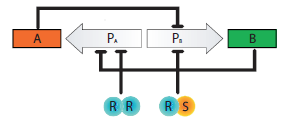How Gene Circuits Store Information
September 20, 2010 | Source: the physics ArXiv blog

Conditional memory circuit regulated by the transcription factors R andS. They form hetero- and homodimers RS and R2 repressing the transcriptionof gene A and B, respectively. The circuit remembers the expressionstate of S during the last pulse of R. Hence, R functions as a read signal for theinformation contained in S,regulated by the transcription factors R and S.
This memory circuit is essentially a modified version of the well-known genetic toggle switch, which consists of two mutually repressing genes and can exist in one of two states. The difference is that this circuit is controlled by the concentration of another protein.
At high concentrations, the circuit is primed to store data in the form of another protein. At low concentrations, the circuit ignores what’s going on. That gives an extra layer of control over the simple toggle switch.
This is sequential logic that depends crucially on the history of input signals. So conditional memory would enable cells to manipulate information “collected” under different conditions at different times, as observed in certain types of cells.
Ref: arxiv.org/abs/q-bio/0701011: Designing Sequential Transcription Logic: A Simple Genetic Circuit For Conditional Memory